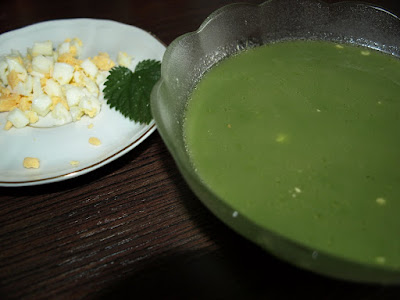Kazakh: қалақай
Upper Sorbian: wulka kopřiwa
Ossetian: Пысыра
Arabic: القراص
Quechua: ithapallu
Greek: Τσουκνίδα
Armenian: եղիճ
Icelandic: netla
Estonian: kõrvenõges
I am a big fan of nettle, so I really egg on all the people to eat it, especially now, in the spring time. The nutritious value of nettle is countless and if you know how to prepare it, it will taste really great, especially for spinach-fans. But remember to collect only the young nettles, those before blooming, caose only they contain tons of vitamins, minerals and flavonoids. Some tips? Prepare nettle leaves just like spinach and eat with curd cheese or use as a filling to pierogi (dough recipe here and here) or vegetable pie or quiche; add nettle leaves to salads and vegetable fritters; combine chopped leaves with fresh cottage cheese and garlic or add the leaves to scrambled eggs or omlette; finally, cook netle soup! One of the variants you can find below!
see also: Russian nettle borscht
1 l. broth
1 cup nettle leaves
1 big onion
1 egg
(optionally: 1/2 cup cream)*
1. Boil 1 cup water, add nettle leaves and leave for 1 minute. Throw the water away (this will take the excessive sipcy taste away) and put the nettle leaves into cooking broth and cook on a low heat for about 15 minutes.
2. Dice onion and fry with a bit of oil until soft and golden.
3. Blend nettle leaves and pieces of fried onion with a bit of broth. Mix with the rest of the broth.

Serve with cooked chopped egg (about 1/2 - 1/3 egg pro person). You can also add cream to cooking broth or blend the cream with nettles and onion, or put a bit of cream on each plate before serving the soup*; you can also sprinkle your soup with copped almonds, pine nuts or bread chunks (fried with oil and garlic and diced)

And here is another lovely nettle soup which I made at my grandmother's place (beautiful eastern Polish countryside)










